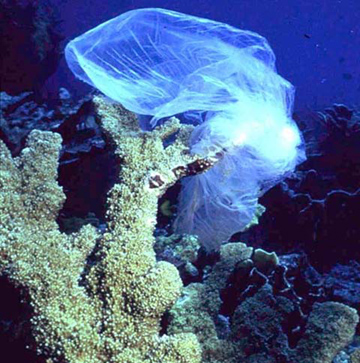In the oceans, one organism’s trash may be another’s treasure. Bits of plastic that wash into the sea can choke or entangle birds, turtles, and other large creatures. But they may also be perfect homes for microscopic creatures, who can turn a plastic chip into a thriving colony — an ecological niche known as the plastisphere.
 Plastic trash caught on a coral. Credit: National Oceanic and Atmospheric Administration
Plastic trash caught on a coral. Credit: National Oceanic and Atmospheric AdministrationMillions of tons of plastic trash float atop the oceans. Although plastic doesn’t degrade very easily, it does break up into smaller pieces, which can float for decades.
In a recent study, researchers skimmed some of these small bits of debris from the North Atlantic Ocean. They examined the material under an electron microscope, and analyzed the DNA of organisms clinging to the plastic.
They found that each little bit of debris hosted its own thriving ecosystem. Some contained hundreds of different species of organisms — an entire food chain floating on a plastic raft that might be no bigger than the head of a pin.
Tiny pits in these rafts contained plastic-eating microbes. That suggests that the plastic might eventually be consumed by these creatures, ridding the oceans of at least some of the trash.
The populations on these plastic rafts can be quite different from that of the water around them, showing that organisms are hitchhiking across long distances. Some of them are nasty — the same type of bacteria that cause cholera and other health problems. So while bacteria may get rid of some of the trash, they may also carry diseases far across the oceans.

